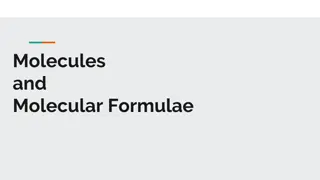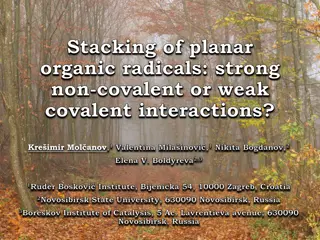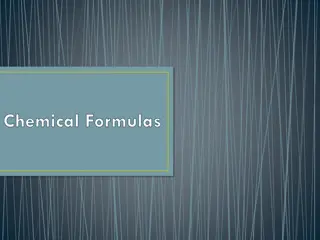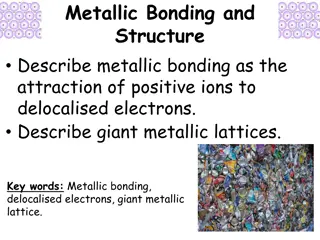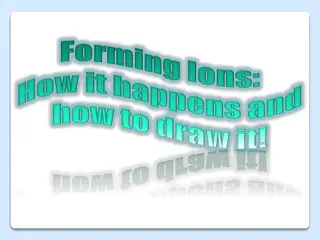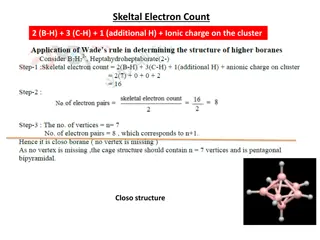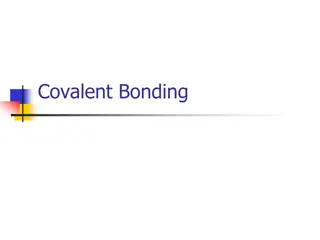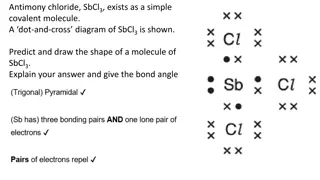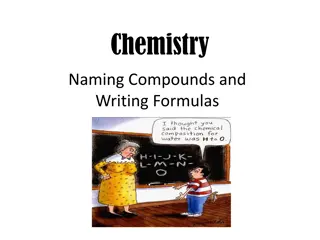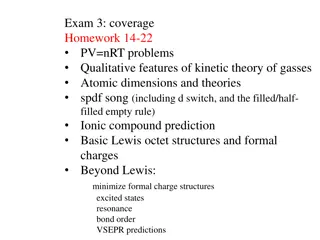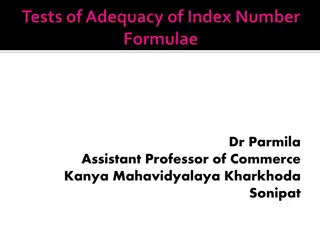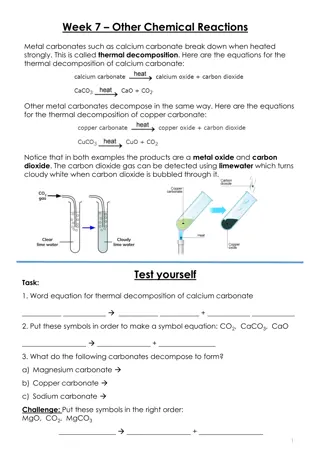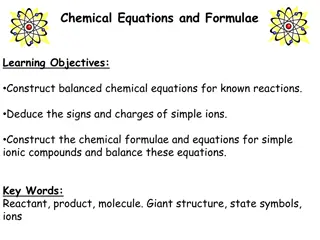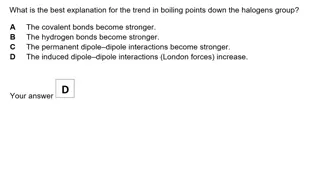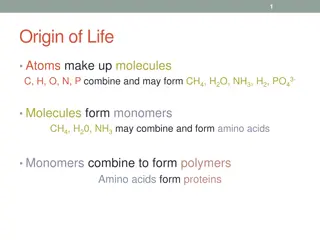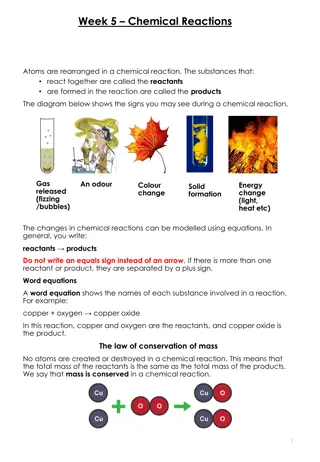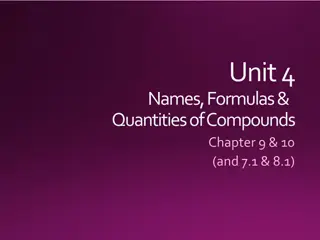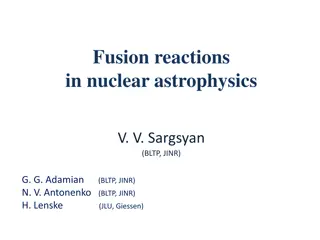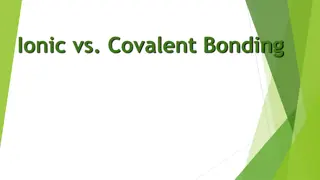Understanding Chemical Bonding: Valency, Formulas, and Reactions
Explore the world of chemical bonding with this unit covering valencies, chemical formulas, ionic vs. covalent bonds, and exothermic vs. endothermic reactions. Learn to predict element combinations, create molecular formulas, and differentiate between various bond types. Jigsaw diagrams demonstrate the structures of molecules like silver chloride, potassium oxide, copper sulfate, and sodium nitrate, helping you grasp their molecular formulas. Dive into the basics of chemistry and enhance your comprehension of fundamental concepts through practical examples and explanations.
Download Presentation

Please find below an Image/Link to download the presentation.
The content on the website is provided AS IS for your information and personal use only. It may not be sold, licensed, or shared on other websites without obtaining consent from the author. Download presentation by click this link. If you encounter any issues during the download, it is possible that the publisher has removed the file from their server.
E N D
Presentation Transcript
At the end of this unit you should: 1. Be able to use the valencies of elements from the periodic table to predict how they combine with other elements. 2. Form a chemical formula for a substance based on valency. 3. Explain the difference between ionic and covalent bonds. 4. Explain the differences between exothermic and endothermic reactions by using a diagram.
activation energy endothermic bond energy profile catalyst enzyme charge exothermic chemical reaction ion combustion ionic bond compound molecular formula covalent bond molecules electron pair valency
Valency: The number of electrons an atom must lose, gain or share to form a stable outer shell and chemically combine with other atoms. Molecule: Composed of two or more atoms chemically combined. Chemical Reaction: The creation of one or more new substances from atoms or molecules.
Ion: An atom or small molecule that has lost or gained electrons to become charged. Charge: The number showing how positive or negative a particle is. Molecular Formula: The number of atoms of each element in one molecule of a compound. Compound: Composed of two or more different elements chemically combined.
(a) Draw jigsaw diagrams for the following molecules: (i) silver chloride
(a) Draw jigsaw diagrams for the following molecules: (ii) potassium oxide
(a) Draw jigsaw diagrams for the following molecules: (iii) copper sulfate
(a) Draw jigsaw diagrams for the following molecules: (iv) sodium nitrate.
(b) Using your jigsaw diagrams, write down the molecular formula for these four molecules. Silver chloride = AgCl Potassium oxide = K2O Copper sulfate = CuSO4 Sodium Nitrate = NaNO3
LIGHTBULB QUESTION The atoms become more stable when this happens because their outer shell either fills up or the outer shell empties so that the next shell in becomes a full outer shell. Do you think it is possible to share electrons? How might this be done?
Ionic Bond: The force of attraction of oppositely charged ions. Covalent Bond: The sharing of pairs of electrons between ions to form stable outer shells.
(a) Draw a diagram of the covalent bonding in fluorine F2 (single bond).
(b) Draw a diagram of the covalent bonding in carbon dioxide CO2 (double bond).
(c) Draw a diagram of the covalent bonding in PCI3 (phosphorus pentachloride).
Activation Energy: The minimum amount of energy that has to be added to the reactant energy to get the reaction started (Eact). Combustion: The chemical reaction between any substance and a gas that releases energy.
Exothermic: A chemical reaction in which energy is released into the surroundings. Endothermic: A chemical reaction in which energy is absorbed from the surroundings.
DEMONSTRATION Demonstration 07.03.01 Creating a fireball Equipment: Retort stand and clamp, filter funnel, rubber tubing, coffee whitener (Coffee Mate or generic coffee creamer ), spatula/teaspoon, Bunsen burner.
DEMONSTRATION Instructions: 1. Set up the apparatus as shown in the diagram. 2. The filter funnel should be half-filled and tilted at an angle so that the coffee whitener will be projected into the hottest part of the flame and not more than 1.0 m from the flame. 3. You should be no nearer than 1.5 m. 4. Place a teaspoon of coffee whitener into a glass petri dish and burn with the Bunsen flame until melted/charred. 5. A deep breath should be exhaled through the tube so that the coffee whitener falls as a powder cloud on the flame. The tube should be released immediately after exhalation to prevent suck- back. A fireball should rise from the Bunsen and its heat should be felt by students.
1. Why does the coffee whitener burn rapidly when blown into the air but not when in a pile of powder? You can verify this by placing a match into a glass petri dish with a teaspoon of Coffee Mate. When separated into separate particles (or smaller groups of particles) in a cloud a greater number of particles are combusted at once, which means a lot of excess bonding energy is rapidly released as heat energy.
2. What other gas, besides the Bunsen gas, aids the combustion in this investigation? Oxygen.
Investigation 07.03.01: Exothermic or endothermic? Equipment: Retort stand and clamp, thermometer, Styrofoam cup, large beaker/ring clamp, five 100 ml beakers (to hold stock solutions), 10 ml graduated cylinder, 10 cm3 sodium hydroxide solution 0.5 M, 10 cm3 dilute hydrochloric acid 0.5 M, 10 cm3 sodium hydrogen carbonate solution 0.5 M (42 g/ 1000 cm3), four spatula measures citric acid, 10 cm3 copper (II) sulfate solution 0.5 M (80 g/1000 cm3), 3 cm magnesium ribbon, four spatula measures magnesium powder, 10 cm3 dilute sulfuric acid 0.5 M.
Instructions: 1. Set up the apparatus as shown in the diagram. As a safety measure, the Styrofoam cup should be placed inside a large beaker to prevent toppling. Alternatively a ring clamp could be used. 2. Transfer 10 cm3 of sodium hydroxide solution to the Styrofoam cup and record its temperature. 3. Stir the mixture with the thermometer while adding 10 cm3 of dilute hydrochloric acid solution. 4. Clamp the thermometer to the retort stand and record the maximum temperature the mixture reaches. 5. Rinse the Styrofoam cup and thermometer thoroughly with water, and wipe with tissue. 6. Repeat the procedure for: sodium hydrogen carbonate solution + citric acid copper (II) sulfate solution + magnesium powder dilute sulfuric acid + magnesium ribbon.
1. List three factors that need to be monitored to ensure a fair test. Factors affecting a fair test: room temperature initial temperature of the reaction mixture the amount of each reactant the amount of stirring of each mixture nature of reactants (solid, liquid, fine or large pieces).
2. Why should the acids be added to the other reactants slowly? Acids tend to be more reactive than other substances so they are normally added slowly to control the speed/vigour of the reaction. The magnesium strip can be safely added as it is a small amount of metal and the acid concentration is not very high. In this case it is safer to add a small solid to a liquid.
3. Why should the thermometer be set in a clamp? To prevent toppling of the Styrofoam cup and to ensure that the thermometer is reading the temperature of the reaction mixture and not the reaction vessel.
Energy Profile: A diagram showing the changes in energy levels in a reaction.
Catalyst: A substance that speeds up a reaction by reducing the activation energy, but is not used up. Enzymes: Protein catalysts used by organisms to speed up biochemical reactions.
It is difficult to measure the change in heat energy directly during an investigation. Temperature changes are used to indicate heat energy increases and decreases. At the start of one investigation, the temperature of the reactants was -32 C; at the end of the investigation the temperature of the products was -21 C. Draw the energy profile diagram that suits this reaction. Note that your reaction profile should be endothermic.
Investigation 07.03.02: Testing the action of protein catalysts Equipment: 25 cm3 graduated cylinder, 5 volume H2O2 solution (50 cm3/1 000 cm3) in a 100 ml flask, potato, celery, liver (lamb or beef), 100 ml conical flask, wooden splints, matches/kitchen lighter, stop clock, filter funnel.
Instructions: 1. Using a graduated cylinder, transfer 25 cm3 of hydrogen peroxide solution into a 100 ml conical flask. 2. Add a fixed mass of liver (approximately 10 grams). 3. Test the gas given off with a glowing splint. Time how long it took for sufficient gas to be produced, for testing. 4. Empty the conical flask and rinse thoroughly. 5. Repeat the procedure with the same fixed mass of potato and then celery.
1. What factors should you control to make sure that this is a fair test? Fair test factors: room temperature initial H2O2 temperature mass of sample nature of sample (wet, dry, powdered, whole, fresh, stale) storage temperature of the sample cross-contamination as the conical flask is re-used the volume of the conical flask if the flask is too big, the liberated H2 may not reach sufficient concentration to ignite.
2. Can you explain why a glowing splint is needed for this investigation? To ignite the liberated H2 gas to prove that catalysis of the H2O2 has taken place.
3. What conclusion can you make about the sources of catalase based on your observations? Considering the sources, the amount of H2 gas liberated will differ as they will not all have the same concentration of H2O2 per gram. The storage temperatures and freshness of the samples could have an effect also.
4. Does it matter which animal the liver comes from? How could you prove this? No, but testing the livers of different animals would show that the catalase concentration is not the same for each organism.
Copy and Complete In this unit I learned that valency is the number of electrons an atom can lose, gain or share to form a bond. The creation of one or more new substances from atoms or molecules is called a chemical reaction. An ion is an atom or small group of atoms that has lost or gained electrons to become charged. The charge is the number showing how positive or negative an ionis. A chemical formula is a set of numbers and symbols used to explain the parts of a chemical compound.
Copy and Complete When atoms lose or gain electrons to form a bond it is called an ionic bond. When atoms share electrons to form a bond it is called a covalent bond. The minimum amount of energy needed for a chemical reaction to happen is called the activation energy. A chemical reaction that releases energy is called an exothermic reaction. A chemical reaction that absorbs energy is called an endothermic reaction. Combustion happens in a reaction between oxygen and another substance that releases energy. A catalyst is a substance that speeds up a reaction without being used up.
1. Using the valencies as listed in Table 07.03.01, find the chemical formula for each of the following: (i) potassium chloride KCl (ii) calcium oxide CaO (iii) lithium oxide Li2O (iv) barium oxide Ba2O (v) calcium hydroxide Ca(OH)2 (vi) manganese dioxide. MnO2
2. Draw a diagram or make a model of the covalent bonding in: (i) carbon tetrachloride CCl4 (single bond)
2. Draw a diagram or make a model of the covalent bonding in: (ii) carbon disulfide CS2 (double bond).
3. Each of the reactions below is matched with a reaction type. State whether the statements are True or False. (i) Petrol and oxygen combining in a car engine is an endothermic reaction. False (ii) Burning coal is an exothermic reaction. True (iii) Sodium hydroxide and hydrochloric acid is an endothermic reaction. False (iv) Sodium hydrogen carbonate and citric acid is an exothermic reaction. False
3. Each of the reactions below is matched with a reaction type. State whether the statements are True or False. (v) Copper sulfate and magnesium powder is an exothermic reaction. True (vi) Sulfuric acid and magnesium ribbon is an exothermic reaction. True
4. Complete the energy profile in Fig. 07.03.09 stating whether it is an exothermic or endothermic reaction. Suggest a reaction not already mentioned that would have this energy profile.
4. Complete the energy profile in Fig. 07.03.09 stating whether it is an exothermic or endothermic reaction. Suggest a reaction not already mentioned that would have this energy profile. Any combustion reaction; neutralisation of acid and base; rusting of iron.
5. Explain, using a sketch, how the energy profile for a reaction using a catalyst would be different. When a catalyst is used, less energy is needed to start the reaction so the peak of the energy profile curve is lower. The catalyst doesn t change the energy of the reactant or the products, only the energy level at which they react.


